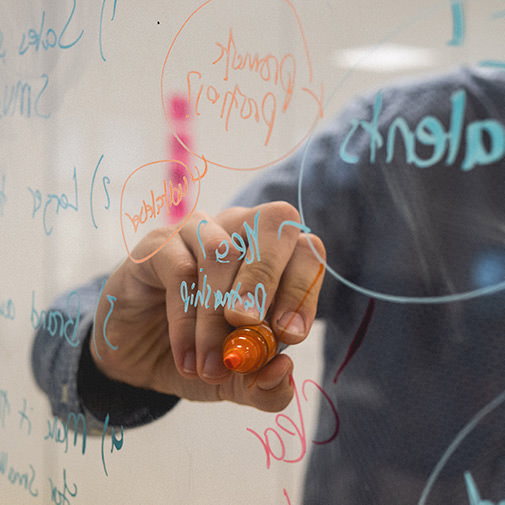We are entering uncharted territory. In the coming years, CEOs will be challenged like never before.
Bill Gates has described the AI revolution as “fundamental as the creation of the microprocessor, the personal computer, the Internet, and the mobile phone.” That’s a big deal. But, it’s also something we can wrap our heads around. After all, we just spent the last twenty plus years making sense of digital transformation.
At the same time, more than 1,000 AI researchers, academics, and tech leaders just signed an open letter urging a moratorium on the development of even more powerful AI, warning that it presents “profound risks to society and humanity.”
Maybe, the analogy we have in our heads about what AI means isn’t sufficient. The scale and scope of it feels different this time.
While we can be certain that the coming disruption will remake our organization, there’s a good chance we will get it wrong. The speed of change may well overwhelm our ability to make good choices. This is all the more reason to establish some firm groundrules so we understand how—and more importantly why—we should use AI to transform our organization. A lot of good leadership decisions are based on prior experience. AI is qualitatively different; there’s no playbook to turn to from the last time this happened. But, there are a few, relevant ideas we can combine to make better decisions that will position our organizations for success.
AI and Disruption to White Collar Work: A Definition
Given that, for the first time, the novel target of AI’s disruptive potential is white collar work, we need a better understanding of the purpose of this kind of work. It may seem obvious, but there are a few ways to think about it. We should spend a bit of time thinking through what it’s for before we start sweeping away jobs through AI-driven automation.
Roger Martin offers among the best definitions, as outlined in his HBR article “Rethinking the Decision Factory.” He notes that any large company has a product or service factory at its heart. GM or P&G have literal factories that create products in the form of cars or personal goods. Bank of America or Verizon also have factories, but ones that produce services in the form of bank branches or digital experiences.
But, the workforce in headquarters are removed from these production activities and frequently misconstrue the function of management as coordination and control. They think the job of management is to ensure the factories are directed well so they do what they’re supposed to. From this definition, what gets measured is adherence to plans. This is such a common definition (and lived experience) of management that few see the problem here. How else could it be understood?
Martin argues that “a more useful conceptualization is that they work in factories too, but their output is decisions. The entire white-collar workforce of the modern company works in decision factories where they pump out decisions such as what and how much to produce, how to market and sell what is produced, what new things to consider producing and selling, where to sell,” etc.
In this view of the large, modern company, the correct way to organize is around decisions: measure output in terms of decisions; measure and work on enhancing the productivity of producing decisions; and so on.
Of course, few companies organize their management operations around decisions. Instead, most businesses borrow their organizational model from their product and services factories and organize around flat jobs, jobs where the person comes to work everyday and performs the same tasks. But, decisions are lumpy, so Martin argues the decision factory needs to be organized around projects, not flat jobs.
I suggest that this is the crux of the problem with innovation in established companies.
For a long time now, organizations have struggled to find the right innovation model and to balance core business operations with exploration and experimentation. One key blocker has been the flat jobs powering the coordination and control managerial structure. They consume a lot of oxygen on repetitive tasks that keep everyone busy. There’s never sufficient time or space for innovation in the core business. Often referred to as “the frozen middle,” this apparent cultural challenge is actually the result of the organization’s conceptualization of management as Martin describes.
Where AI Comes In
The good news is that AI may change that. Noah Smith likens their impact to machine tools:
“Large language models like ChatGPT — the kind of AI that everyone is excited about and afraid of — are a machine tool. They allow human beings to produce more output with less work. For example, GitHub copilot allows programmers to get their jobs done in about half the time (and it makes the job more pleasant as well). But code is only one example of what humans can produce using AI tools — think of PowerPoint presentations, business emails, memos, grant applications, advertisements, instruction manuals, corporate paperwork, health forms, government paperwork, legal briefs, or anything that involves writing. Currently, a lot of our time and effort is spent producing this stuff; LLMs could cut that time and effort down by a lot, just like machine tools made it easier to shape metal and plastic in a factory.”
Smith argues that combined with their function as a how-to-manual for any task, AI allows the majority of workers to do things only the smartest or most talented workers could do previously. This creates some interesting possibilities when considered in light of the decision factory.
If one of the key blockers has been the flat job, and if one of the reason for the flat job is to accommodate normal limitations in the workforce, then AI could conceivably break this logjam. All kinds of interesting things become possible as a result. Of course, many tasks simply go away, like the artisanal hand-work that machine tools replaced. At the same time, leaders suddenly have new-found expertise throughout their organization. They have been handed a resource they didn’t know they had. But, it not just you. Every organization now potentially has this new capacity, which raises the bar and demands not just more efficiency, but greater and faster adaptation.
Martin’s conception of the decision factory has always been compelling to anyone who wants to see the core business and the innovation function more closely intertwined. We’ve had few good examples of this, however, outside of acacdemic papers. AI may cause that to change.
Avoiding the Efficiency Trap
The temptation will be to streamline functions as they exist today, to cut jobs and let the machines do it. But, because everyone has access to these same tools, AI establishes a new competitive floor. A singular concern with the automation of tasks misses the larger challenge around unleashing the power of better decisions. The inputs for better decisions, as Martin points out, include creativity, empathy, and insights; design thinking, in other words.
Already, organizations face competitive disruption when they stand still too long and over-optimize existing processes. They struggle to sustain investment in, and to see ROI from, their innovation activities; too often, in fact, the innovation function is itself another silo. AI will make these problems all the more evident and acute, which is why it’s essential we take a larger view.
That view requires that leaders consider not just the efficiency gains in front of them today, but the scrambled competitive landscape of tomorrow. In this environment, some of the new capacity made available by the AI revolution can and should be reallocated to innovation and adaptation. There may be a golden opportunity before us to finally break the logjam that has held back organizations from truly seeing the benefits of innovation by freeing management from an exclusive focus on command and control
The notion of the decision factory offers a framework not just to effect change at the level of the task or job, but at the level of the organization. And that’s what’s demanded by the scale of disruption we’re facing.
```
A version of this article was originally published in Innovation Leader’s journal, Pointers.



